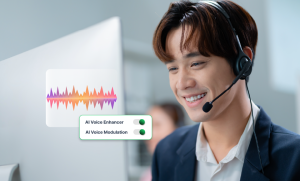A customer calls your support line, frustrated and looking for help. Your agent knows exactly how to solve the problem. But there’s a catch—the customer struggles to understand the agent’s accent. The call drags on. Frustration builds on both sides. The customer hangs up unsatisfied.
This scenario plays out millions of times every day across contact centers serving the world’s 17 million customer service agents. But there’s a new solution changing the game: voice harmonization. This AI-powered technology adjusts speech patterns in real-time, making conversations clearer while keeping each person’s unique voice intact. It’s not about erasing accents—it’s about ensuring everyone gets heard and understood.
In this guide, we’ll explore how AI harmonizer and accent conversion technologies work, why they matter for business, and how organizations can use them responsibly to serve customers better.
What is Accent Harmonizer?
Before we dive into solutions, let’s get clear on what we’re talking about. The world of voice AI uses several terms that sound similar but mean different things. Understanding these differences matters if you’re evaluating this technology for your business.
Voice and accent harmonization is the umbrella term for AI-powered technology that adjusts speech patterns in real-time. Think of it like a smart filter that makes speech clearer while keeping the speaker’s unique voice qualities—their warmth, their personality, their emotional tone. The goal isn’t to make everyone sound the same. It’s to reduce confusion and help conversations flow smoothly.
Now, here’s where it gets specific. Accent conversion is one technique within voice harmonization. It converts or adjusts one accent into another. This happens automatically, in the moment, as people speak.
Here’s a helpful way to think about it:
- Speech-to-speech (STS) systems transform audio directly to audio, like our harmonization technology
- Text-to-speech (TTS) systems convert written words into spoken audio, like what you hear from Siri or Alexa
- Voice harmonization uses STS because it preserves the speaker’s unique vocal qualities
Why Traditional Approaches Fail?
Companies have tried solving accent challenges through training programs and hiring strategies. These legacy methods made sense in a slower, more localized world. But today’s global, always-on communication demands expose their serious limitations.
Traditional accent coaching has been the go-to solution for years. Companies hire trainers to help agents modify their speech patterns over weeks or months. The programs can cost thousands of dollars per agent. Even with that investment, results vary wildly. Some agents improve noticeably. Others struggle despite their best efforts. Many feel uncomfortable or even insulted by the implication that their natural way of speaking isn’t good enough.
Beyond the costs and mixed results, accent coaching faces another problem: time. Training takes months while customers need help today. New hires can’t wait twelve weeks before taking calls. The business loses productivity, and agents feel stressed before they even start.
The Business Impact of Accent Friction
The real cost of accent challenges shows up in measurable business metrics. When customers struggle to understand agents, calls take longer. Average Handling Time (AHT) creeps up. What should be a five-minute conversation stretches to eight or ten minutes. Multiply that across thousands of daily calls, and you’re looking at serious operational costs.
Customer satisfaction suffers too. Your frustration has nothing to do with the agent’s knowledge or helpfulness—it’s purely about clarity. Yet your satisfaction score still drops. The agent feels that sting even though it’s not their fault.
For agents themselves, accent friction creates chronic stress. They know they’re providing good service, but they sense customer frustration. Over time, this erodes confidence and job satisfaction. Turnover increases. The cycle continues.
Real-time communication makes everything harder. In-person conversations, phone calls, and video meetings demand instant responses. There’s no time for processing or revision. The speech has to be clear the first time, every time. Traditional training methods can’t solve this because they require conscious thought and practice. What we need is technology that works automatically, in the moment, without the speaker having to think about it.
How Voice Harmonization & AI Accent Conversion Work?
Modern AI has solved what seemed impossible just a few years ago: adjusting accents in real-time while keeping each person’s unique voice intact. The technology behind this breakthrough combines several advanced techniques working together seamlessly. Let’s break down how it works:
Core Technical Mechanism
At its heart, voice harmonization operates at the level of individual speech sounds. Remember those phonemes we mentioned earlier? The AI system identifies each phoneme as someone speaks, then adjusts the ones that cause confusion. It’s like having an invisible translator that works on sounds instead of words.
Phoneme-level correction happens lightning-fast. When an agent says something, the AI catches the word instantly. It adjusts that specific sound while leaving everything else untouched. The customer hears the word clearly, but the agent’s voice still sounds like their own voice.
Context-aware modeling makes this even smarter. The AI doesn’t just process sounds in isolation—it understands meaning. This system preserves the warmth and reassurance in the speaker’s tone while making the words clearer. This matters enormously for customer service, where how you say something is just as important as what you say.
Moreover, voice cloning technology plays a crucial role here. The AI learns the speaker’s vocal characteristics in real-time. It maps their pitch range, their speech rhythm, and their unique timbre (that’s the quality that makes your voice sound like you and nobody else.
The Speech Processing Chain
Let’s walk through what happens in the split second between when an agent speaks and when a customer hears them. Understanding this flow helps clarify why the technology works so well.
Step 1: Audio Capture – The agent speaks naturally into their headset or computer microphone. They’re not thinking about their accent or trying to modify their speech. They’re focused entirely on helping the customer. The system captures their voice in its raw, natural form.
Step 2: Feature Extraction – In milliseconds, the AI analyzes the audio stream. It identifies acoustic properties: What’s the pitch? What phonemes is the speaker using? What’s the emotional tone? The system creates a detailed map of the speech characteristics, working faster than the human ear can process sound.
Step 3: Harmonization Engine – This is where the magic happens. The AI applies real-time accent adjustment based on everything it learned during training. It knows which phoneme adjustments will improve clarity for the target audience. It makes those changes while leaving everything else intact. The emotional warmth stays. The speaker’s unique voice quality stays. Only the potentially confusing sounds get adjusted.
Step 4: Voice Synthesis – The AI reconstructs the audio with the adjustments applied. This isn’t creating an entirely new voice—it’s modifying the original voice just enough to enhance clarity. Think of it like adjusting a photograph’s exposure without changing what’s in the picture.
Step 5: Output Delivery – The harmonized audio travels to the customer in real-time. They hear speech that’s clear and easy to understand, delivered in a voice that still sounds natural and human. The entire process happens so fast that there’s no noticeable delay in the conversation.
Performance Metrics & Technical Benchmarks
How do we measure whether voice harmonization works? Several key metrics tell the story.
- Latency sits at the top of the list. As we mentioned, keeping processing time under 200 milliseconds is non-negotiable. The best systems target even lower latency—some aim for under 100 milliseconds. Every millisecond matters in creating natural conversation flow.
- Word Error Rate (WER) measures how accurately the system recognizes speech. If the AI misunderstands what someone said, it can’t harmonize it properly. Leading systems achieve WER below 5% for most accents and speaking conditions. That means they correctly identify 95 out of every 100 words.
- Phoneme Error Rate (PER) gets more granular. It measures how precisely the system adjusts individual speech sounds. This metric directly relates to clarity improvement. Lower PER means better accent conversion quality.
- Mean Opinion Score (MOS) captures perceptual quality. Real people listen to harmonized speech and rate it on a scale from 1 to 5. Scores above 4.0 indicate excellent quality—speech that sounds natural and clear. The best voice harmonization systems consistently achieve MOS above 4.2.
Omind’s Accent Harmonizer distinguish themselves through several key capabilities. The platform preserves timbre and emotional nuance—you hear clarity without losing warmth. It operates in real-time, not batch processing, making it suitable for live conversations. The system supports edge computing for ultra-low latency when needed. And critically, it handles global accent diversity rather than forcing everything toward a single “neutral” accent.
Real-World Applications: Use-Cases & Business Impact
The technology is impressive—but what truly matters is its ability to solve real business problems and deliver measurable value. Organizations across industries are deploying voice harmonization to tackle specific challenges and generate concrete returns.
Let’s explore where this technology makes the biggest impact:
Global Contact Centers & Customer Service
This is the most immediate and high-value application. The $97.31 billion global call center outsourcing market thrives on connecting skilled agents with customers, but accent friction is a costly problem. This leads to:
- Longer Calls: Agents must repeat themselves, dragging out Average Handling Time (AHT).
- Customer Frustration: Satisfaction scores drop, impacting brand loyalty.
- Agent Morale: Constant requests for repetition lower confidence and increase turnover.
The Transformation and ROI
Voice harmonization transforms this dynamic by ensuring agents can speak naturally while the system adjusts their speech for clarity. Conversations flow smoothly, customers get problems solved faster, and the business metrics shift dramatically.
Hybrid Work and Virtual Collaboration
The shift to remote work created a new challenge: globally distributed teams collaborating in real-time. Accent differences can create subtle but real barriers to full participation.
Voice harmonization smooths these interactions across platforms like Zoom and Teams.
- Equal Contribution: During a meeting with participants from six countries, everyone can speak naturally and be clearly understood. No one holds back for fear of not being comprehended.
- Increased Productivity: The team’s focus stays on content and strategy, not struggling with comprehension.
- Sales Enablement: Global sales engineers can explain complex technical features with full clarity, ensuring their expertise shines through without accent friction distracting prospects.
Other Promising Opportunities
While contact centers and collaboration get the most attention, other applications are emerging:
- Media & Entertainment: Podcasters, audiobook narrators, and voice actors can reach global audiences more effectively. The technology can also be used for localization, adjusting performances while maintaining the original actor’s voice quality and emotional delivery.
- Personalized Voice Assistants: Instead of a single generic AI voice, assistants could adapt their accent to what each user finds most natural and clear, making interactions feel more intuitive and friendly.
Conclusion
AI Voice Harmonization is a powerful, real-time solution that works at the phoneme level. It uses sophisticated technology to adjust confusing speech sounds while preserving the speaker’s unique voice, tone, and emotional nuance.
The automated system helps organization move beyond legacy solutions to achieve:
- Massive Efficiency Gains: Reducing AHT and operational costs.
- Superior CX: Boosting customer satisfaction and loyalty.
- Strategic Talent Access: Opening the hiring pool to the best talent, regardless of geography.
Are you ready to slash your Average Handling Time and expand your global talent pool?
See how Omind’s Accent Harmonizer is transforming contact center metrics. Schedule a personalized demo.























